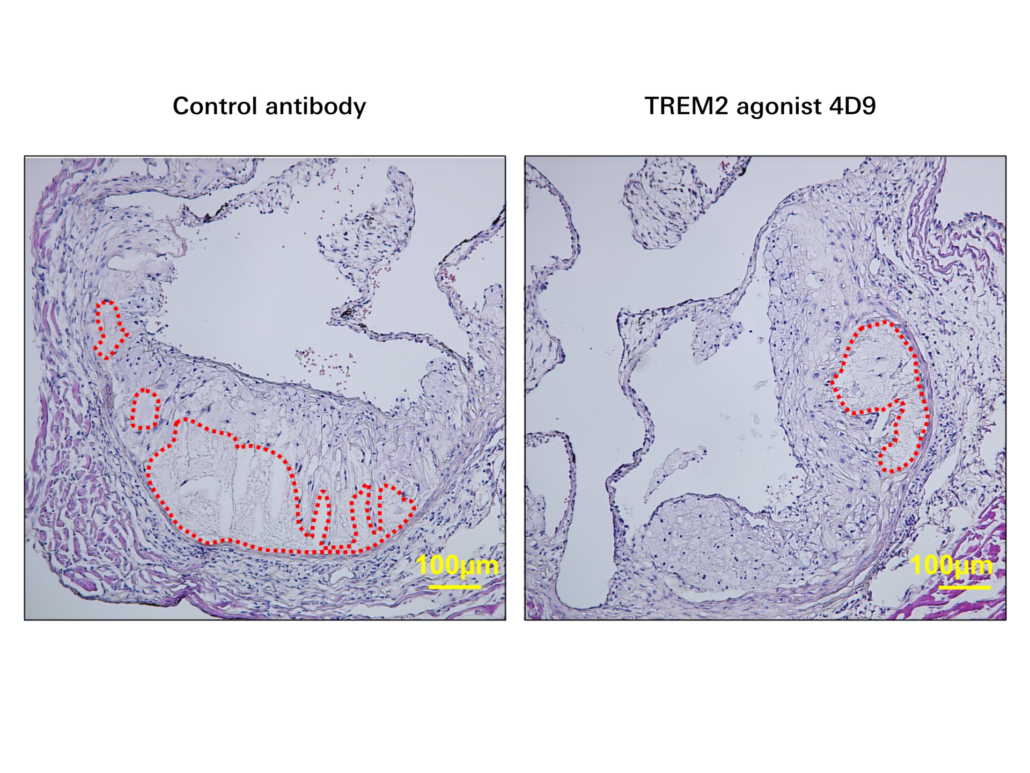
Researcher find potential target for atherosclerosis
TREM2, a receptor on the surface of macrophages, reduces necrotic core formation in early atherosclerosis, a German-Austrian reseach team reports.
Researchers have found a new way to reverse atherosclerotic plaque formation at the early stages. In Nature Cardiovascular Research, Alma Zernecke-Madsen and colleagues from University Wuerzburg and Medical University of Vienna report that hematopoietic or global TREM2 deficiency increased, whereas TREM2 agonism decreased, necrotic core formation in early atherosclerosis. Additionally, the researchers demonstrated that TREM2 is essential for the efferocytosis (clearance of dead cells) capacities of macrophages and to the survival of lipid-laden macrophages (foam cells), indicating a crucial role of TREM2 in maintaining the balance between foam cell death and clearance of dead cells in atherosclerotic lesions, thereby controlling plaque necrosis.
The findings might have a big impact on atherosclerosis prevention as is the chronic disease of the vascular wall driven by lipid accumulation and inflammation in the intimal layer of arteries, drives complications with the highest mortality worldwide such as myocardial infarction and stroke. Recent studies identified the triggering receptor expressed on myeloid cells 2 (TREM2), as a lipid-senor regulating myeloid cell functions. TREM2 is highly expressed in macrophage foam cells in experimental and human atherosclerosis. However, the role of TREM2 in atherosclerosis was not fully unravelled.
“We already knew that foam cells carry the receptor TREM2on their surface and that this receptor regulates macrophage function in different pathologies such as Alzheimer’s or obesity. However, the mechanisms by which the receptor affects atherosclerosis were not yet fully understood,” says Alma Zernecke-Madsen.
A possible therapeutic approach was provided by studies on so-called LDLR-/- mice. Since the LDLR gene was knocked out in these mice, they have an increased concentration of LDL cholesterol in the blood, which increases the risk of developing atherosclerosis. These mice were treated with an agonistic TREM2 antibody named 4D9, produced by Kai Schlepckow and Christian Haass from the German Center for Neurodegenerative Diseases (DZNE) in Munich, which enhanced the activity of TREM2. Stimulating TREM2 using this agonistic antibody reduced the formation of necrotic cores within the atherosclerotic plaques
According to Alma Zernecke-Madsen, Christoph Binder and Clément Cochain, this protective function of TREM2 could be very important, as the accumulation of dead plaque cells significantly influences the stability of the deposits and thus the clinical complications of atherosclerosis. That means: If too many cells die and the damaged cells are not efficiently removed, inflammation and subsequent harmful effects ensue. However, by administering 4D9, fewer cells die and accumulate in the necrotic core.
Furthermore, the researchers were able to collect data demonstrating TREM2 in and serum in atherosclerosis. “Soluble TREM2 (sTREM2) in the blood correlated with the further growth of plaques in the carotid artery of the patients,” describes co-first author Dr. Florentina Porsch. “Together with the results from preclinical animal models, this could suggest that TREM2 could be diagnostically as well as therapeutically useful, which needs to be further researched in the coming years,” says co-first author Marie Piollet.


 Adobe stock photos - Dzmitry
Adobe stock photos - Dzmitry 
